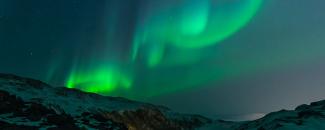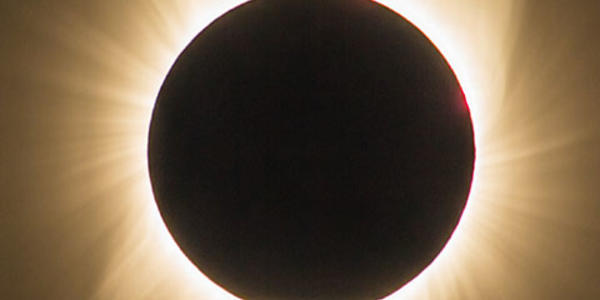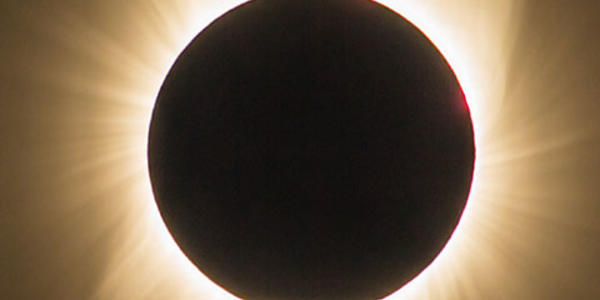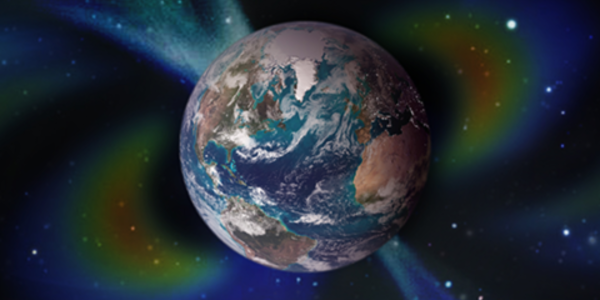
A geomagnetic storm lies behind every inspiring aurora in our skies. The mystery behind these shimmering curtains of neon-like light isn’t a mystery to scientists who study space weather. Rather than the calm before the storm, aurora is the light show after the storm in space.
Auroras above the Northern and Southern Hemispheres evolve from the sun’s activity that affects the conditions in space on an enormous scale. Space weather—caused by solar activity such as solar flares and coronal mass ejections—can impact the space between here and the sun and cause an aurora as a byproduct. Auroras can also be triggered by much less energetic events that lead to active conditions, such as fast solar wind streams from coronal holes. NOAA scientists monitor and track these geomagnetic storms and other phenomena related to space weather.
Space Weather and Magnetism
Although aurora lights appear most frequently near the poles—the aurora borealis to the north and the aurora australis to the south—space weather happens on a much larger scale. Solar matter can be flung past our position 93 million miles from the sun and can reach the remotest edges of our solar system. These eruptions carry as much energy as a modern nuclear reactor could produce if it ran continuously for hundreds of thousands of years.
When these powerful surges arrive at Earth, they reshape our magnetosphere. The magnetosphere is the region of space surrounding Earth where the dominant magnetic field is the magnetic field of Earth, rather than the magnetic field of interplanetary space. Electrically conductive plasmas in the solar wind and the magnetosphere are not free to cross one another, so when solar winds hit the magnetosphere they don’t flow through our magnetic bubble but must go around. The force of the wind as it impacts and flows around the magnetosphere affects the shape of the magnetosphere. The shape and size of Earth’s magnetic field continually change as the field is buffeted by solar wind.
 Structure of Earth's magnetosphere. Courtesy of Wikimedia Commons.
Structure of Earth's magnetosphere. Courtesy of Wikimedia Commons.
Earth’s magnetic field lines converge at the geomagnetic north and south poles, which are offset from the geographic poles. Magnetospheric electrons can be accelerated by various processes and are lost to the atmosphere as they flow along magnetic field lines in the polar regions towards the Earth. There, they collide with oxygen and nitrogen atoms in Earth’s upper atmosphere. From this interaction, auroral light is emitted.
Viewing an Aurora Light Show
The chances of glimpsing these spectacular “dancing” lights improve during certain times of the year and under certain conditions. The closer a skywatcher is to the higher latitudes, the more likely auroras will be visible. However, there’s a catch. Earth's magnetic poles are offset from the geographic poles. Views from near Earth's magnetic poles, where the magnetic field converges, are more optimal than from the geographic poles. NCEI’s World Magnetic Model can be used to calculate the location of the magnetic poles. Many locations in Alaska, for instance, are front-row seats for these amazing light displays.
In North America, auroras are most commonly visible in March and November when cloud cover diminishes somewhat. Cloudy or overcast skies decrease visibility, but scientists don’t fully understand the reason that auroras are more frequently observed during these months. Auroral lights are usually only viewable near local midnight. They are generally not visible during daylight hours, although on clearer nights, auroras have been viewed within an hour before and after sunrise.
In vivid reds, greens, yellows, and blues, auroras look like wavy or shimmering curtains that can stretch across the horizon. The green aurora, called "diffuse," can also evolve from the trapped electrons receiving a little extra energy, known as “pitch angle scattering,” and hitting the atmosphere. In either case, the lights pose a curiosity for tourists and polar residents alike.
The Beauty and Mystery of Aurora
Aurora often appears in highly structured ribbons—sheets as thin as a few hundred meters that can stretch for hundreds of kilometers into the atmosphere. These sheets ripple and move across the sky as the aurora evolves, driven by changes in the shape of Earth’s magnetic field in the “tail” of the magnetosphere hundreds of thousands of kilometers away. The magnetosphere is shaped a bit like a raindrop with the wide rounded end, the “bow,” toward the sun, and the thin extended tail away from the sun. Each magnetic field line in the tail connects back to Earth through the magnetic poles, and the thin sheets we see on Earth can be traced back through space to where the “magnetotail” is energized and stretched by interaction with solar wind and the interplanetary magnetic field.
Perhaps more impressively, each magnetic field line that becomes active at the north magnetic pole has a companion in the south, so as observers in Alaska watch the auroral ribbons dance and move in the sky, observers in the Antarctic could watch their own auroral show in their own sky. For each twist and wave of the auroral ribbon in the north, its companion will do the same, not quite in mirror image, but clearly in coordinated motions. Two observers, separated by thousands of kilometers on Earth—oceans and continents apart—can watch nearly the same auroral show, connected by a link through deep space, more than a hundred thousand kilometers long.
Forecasting Aurora
NOAA keeps tabs on the dynamics of the sun, including watching for explosive solar events and clocking solar wind speeds, to prepare for changes in the magnetosphere, which can cause disruptions in communications and electrical systems on the planet.
At polar regions, the aurora borealis and aurora australis show up about half the nights in a given year. NOAA’s Space Weather Prediction Center develops 30-minute forecasts of aurora over both hemispheres based on solar wind speeds. A 3-day forecast is also available. Solar wind strength determines the vibrancy of auroral displays.



